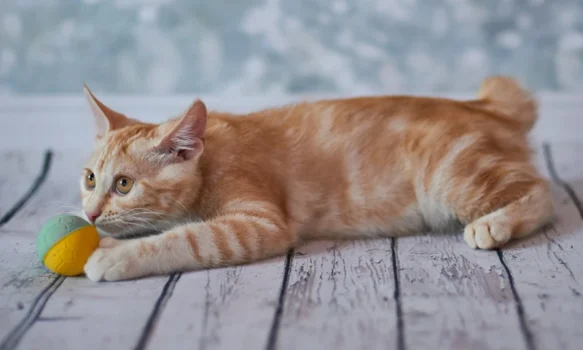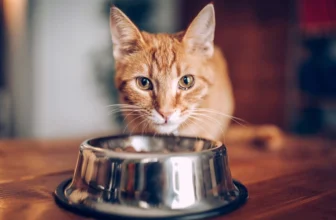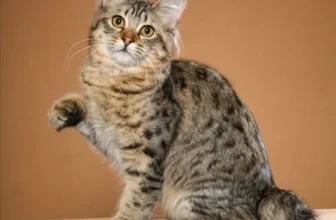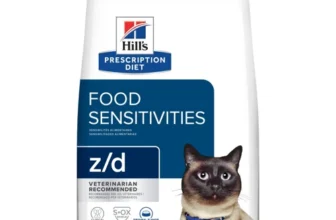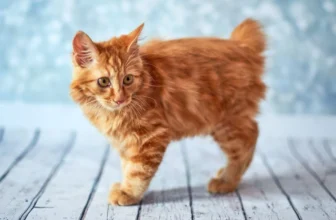Introduction
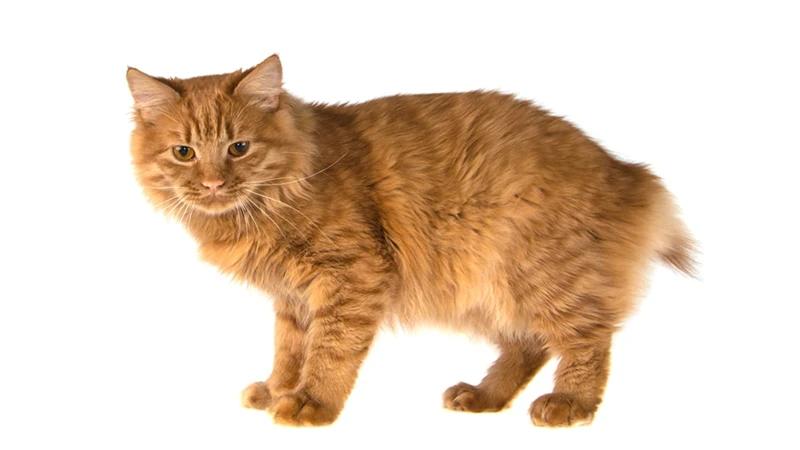
When it comes to owning a pet, it’s important to ensure that their nutritional needs are met to keep them healthy and happy. This is especially true for American Bobtail cats, which have specific dietary requirements. However, with so much information available, it can be overwhelming to know where to start. In this article, we’ll guide you through the best practices for feeding your American Bobtail cat, while also highlighting common mistakes to avoid. By the end, you’ll feel confident in providing the best possible diet for your furry friend. So, let’s get started!
Brief Overview of American Bobtail Cats
American Bobtail cats are a unique breed known for their distinctive bobbed tails, which is their most defining physical feature. These cats are known for their playful personality and are incredibly intelligent, making them excellent pets for families with children.
Size: American Bobtail cats are typically medium to large in size, with males weighing between 11 to 16 pounds and females ranging from 8 to 12 pounds.
Coat: Their coats are usually thick and come in a variety of colors and patterns, such as tabby, calico, and solid colors.
Activity Level: American Bobtails are naturally active and playful cats that require regular exercise and mental stimulation. They enjoy playing and interacting with their owners and other pets.
Health: American Bobtail cats are generally healthy, but they may be prone to some health issues, such as hip dysplasia and obesity.
To keep your American Bobtail cat healthy and happy, it’s important to provide them with a well-balanced diet and avoid making common feeding mistakes. By consistently feeding your cat nutritious meals, in the right portions and at the right times, you can ensure that they maintain a healthy weight and receive the nutrients they need for optimal health.
For more information on feeding American Bobtail cats, read our articles on consistently feeding American Bobtail cats, feeding schedule for American Bobtail, and benefits of feeding American Bobtail at specific times.
Factors to Consider
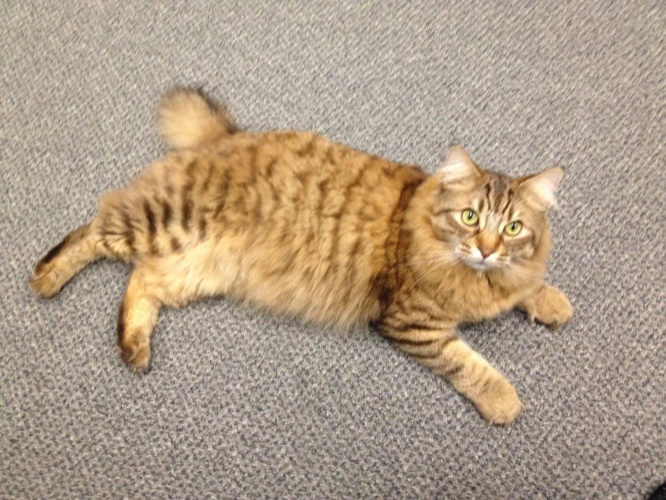
When it comes to feeding your American Bobtail cat, there are several factors to take into account to ensure they receive the appropriate nutrition for their unique needs. From age and weight to activity level and health conditions, it’s important to carefully consider each factor to determine the ideal diet for your feline friend. By prioritizing their nutritional needs, you can help your American Bobtail cat live a long and healthy life full of energy and vitality. Let’s delve deeper into the various factors you should take into account when planning your cat’s diet.
Age and Weight
When it comes to feeding your American Bobtail cat, age and weight are crucial factors to consider. It’s important to understand that nutritional needs vary based on the stage of life and the weight of your furry friend. Here are some tips to keep in mind when it comes to feeding your American Bobtail based on their age and weight:
- Kittens: Kittens should be fed smaller portions more frequently throughout the day. They need a diet that is high in protein and fat to support their rapid growth and development. It’s recommended to feed them kitten-specific food until they reach one year of age.
- Adults: Adult American Bobtail cats tend to have lower energy requirements than growing kittens. They need a balanced diet that is lower in calories and fat but still high in protein. Your veterinarian can recommend an appropriate feeding schedule for your cat based on their specific needs.
- Seniors: As cats age, their metabolism slows down, and their energy needs decrease. Senior cats may need a diet that is lower in calories and fat but still high in protein to maintain lean muscle mass. It’s important to monitor their weight and adjust their diet accordingly.
- Overweight Cats: If your American Bobtail cat is overweight, it’s important to work with your veterinarian to develop a weight loss plan. This may involve feeding your cat smaller portions more frequently throughout the day, switching to a low-calorie cat food, or incorporating more exercise into their daily routine.
Remember, feeding your American Bobtail cat a proper diet based on their specific age and weight is essential to their overall health and well-being. Consulting with your veterinarian can help ensure that they are receiving the right nutrition for their stage of life.
Activity Level
When considering the dietary needs of your American Bobtail cat, it is important to take into account their activity level. Each cat has unique energy requirements based on their daily activities. Some cats are more active than others and will require more food to sustain their energy levels. Conversely, less active cats will need less food to maintain their health.
To determine your American Bobtail cat’s activity level, observe their behavior throughout the day and take note of how much they move around or engage in physical activity. If your cat spends most of their day lounging around and sleeping, they are considered to have a low activity level. However, if your cat is constantly on the move or engaging in play, they have a high activity level.
Once you have determined your American Bobtail cat’s activity level, you can adjust their food intake accordingly. For cats with higher activity levels, provide them with more food to ensure they are receiving enough calories and nutrients to fuel their active lifestyle. On the other hand, overfeeding a less active cat can lead to weight gain and potential health problems.
In addition to adjusting your cat’s food intake, it is also important to incorporate playtime and exercise into their daily routine. This will not only help maintain their ideal weight, but it will also keep them mentally stimulated and prevent boredom.
Understanding and considering your American Bobtail cat’s activity level is crucial in ensuring they receive the proper amount of food and nutrition for their individual needs.
Health Conditions
It is important to consider any present health conditions when feeding your American Bobtail cat. Certain health issues may require changes in their diet to ensure they receive proper nutrition to support their overall health and wellbeing.
Here are some health conditions to keep in mind:
- Obesity: Obesity is a common problem among American Bobtail cats. If your cat is overweight, it is important to adjust their diet to promote healthy weight loss. Talk to your veterinarian and work together to create a balanced diet plan that will help your cat achieve and maintain a healthy weight.
- Dental problems: Dental problems can make it difficult for cats to eat. If your cat has dental issues, you may need to adjust their food to accommodate their needs. Soft, wet food or smaller kibble may be easier for them to eat.
- Food allergies: Some American Bobtail cats may have food allergies that can cause skin irritation, digestive issues, and other health problems. If your cat has a food allergy, it is important to avoid the allergenic ingredient(s) and find a suitable substitute that meets their nutritional needs.
- Kidney disease: Cats with kidney disease may require special diets that are low in phosphorus and sodium. Talk to your veterinarian about appropriate foods and supplements to support kidney function.
- Diabetes: Diabetes is a common problem in cats. A high protein and low carbohydrate diet can help regulate blood sugar levels. However, it is important to work with your veterinarian to create a personalized diet plan for your cat.
Remember, it is important to always consult with your veterinarian before making any significant changes to your American Bobtail cat’s diet, especially if they have any health conditions. A customized diet plan can help ensure your cat is receiving the proper nutrients to support their overall health and wellbeing.
Dietary Needs
American Bobtail cats have unique dietary needs that must be taken into account for a healthy and happy life. In order to ensure that your cat receives proper nutrition, there are a few factors to consider.
Protein: American Bobtail cats require a diet rich in protein. This should come from animal-based sources such as chicken, turkey, or fish. Plant-based proteins may not provide essential amino acids that your cat needs.
Fats: Fats are also an important part of your cat’s diet, providing energy and aiding in the absorption of vitamins. However, it’s important to monitor the amount of fat your cat consumes to prevent obesity.
Carbohydrates: American Bobtail cats do not require carbohydrates in their diet since they have a low-carb metabolism. However, some cat foods may contain carbohydrates as fillers, so it’s important to read labels carefully.
Vitamins and Minerals: A well-balanced cat food should provide all necessary vitamins and minerals, but supplements may be necessary for cats with certain health conditions. Consult with your veterinarian to determine if your cat needs extra vitamins or minerals.
Water: Hydration is crucial for an American Bobtail cat’s health. Ensure that fresh, clean water is always available to prevent dehydration.
By providing a balanced diet that meets your American Bobtail cat’s nutritional needs, your furry friend can live a healthy and happy life. Remember to choose high-quality, protein-rich foods and monitor portion sizes to prevent obesity or other health issues.
Avoidable Mistakes
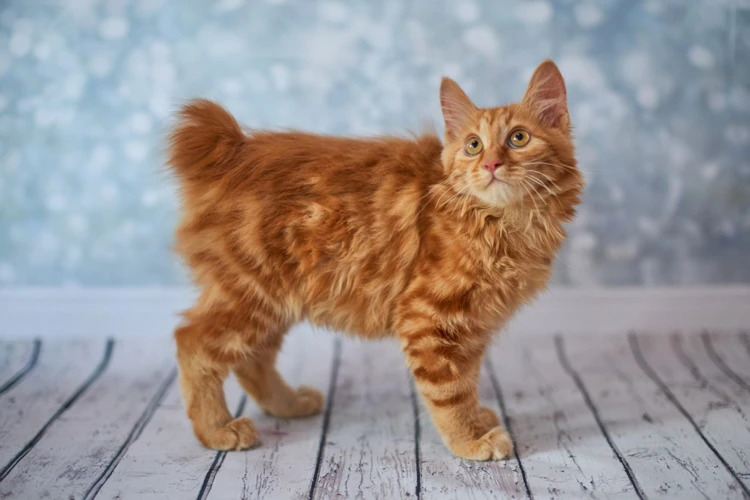
Feeding your American Bobtail Cat properly is crucial for their overall health and well-being. However, there are some avoidable mistakes that cat owners can inadvertently make. These mistakes can have serious consequences on your cat’s health, and it’s important to identify and avoid them. In the following section, we’ll discuss some of the most common avoidable mistakes that many cat owners make when feeding their American Bobtail cats. By understanding these pitfalls, you can keep your feline friend healthy and happy for years to come. So, let’s take a closer look at what you should avoid when it comes to feeding your American Bobtail Cat.
Free-Feeding
Allowing your American Bobtail cat to free-feed is one of the most common mistakes many cat owners make. This feeding approach, which involves providing unlimited food access to your cat, may appear convenient, but it can have disastrous consequences. Here are some reasons why you should reconsider free-feeding your American Bobtail cat:
- Weight gain: Free-feeding your cat can cause your cat to become overweight or even obese. This is because the cat can eat whenever they want, leading to consuming more food than their body needs. Obesity in cats can lead to a range of health problems, such as heart disease, diabetes, and joint pain.
- Lack of portion control: Without controlled portions, it’s challenging to gauge how much food your cat consumes daily, so it’s difficult to monitor their calorie intake accurately. This can make it challenging to manage your American Bobtail’s weight and nutritional needs.
- Food spoilage: When you provide your cat with an unlimited supply of food, it may sit out for long periods, making it more prone to spoilage, attracting pests, and becoming less nutritious over time.
- Unhealthy eating patterns: Free-feeding can lead to unhealthy eating patterns for your American Bobtail. When a cat is hungry, they may eat too quickly, making them feel unwell or bloated. On the other hand, if your cat doesn’t have an appetite, they may not eat for an extended period, leading to malnourishment or nutrient deficiencies.
Instead of free-feeding, it’s best to offer your American Bobtail cat smaller, portion-controlled meals throughout the day. This feeding approach provides a more accurate method of controlling your cat’s calorie intake, ensuring their nutritional needs are met, and keeping their weight under control.
Inadequate Water Access
Water is an essential nutrient for all living organisms, and cats are no exception. Inadequate water intake can lead to dehydration, which can cause serious health problems for your American Bobtail cat. It is crucial to ensure that your cat has proper access to water at all times.
Here are some common mistakes regarding inadequate water access that cat owners should avoid:
- Not providing enough water: Cats require a certain amount of water per day based on their weight and diet. Failure to provide the necessary amount of water can lead to dehydration. It is recommended to provide fresh, clean water in a bowl that is easily accessible for your cat at all times.
- Using small or inadequate water bowls: If the water bowl is too small, or if it gets empty quickly, your cat may not have enough water throughout the day. Make sure that the water bowl is large enough to hold an adequate amount of water for your cat and is easily accessible.
- Not cleaning the water bowl regularly: Dirty water bowls can harbor harmful bacteria, which can lead to urinary tract infections and other health issues. Make sure to clean and refill the water bowl daily to ensure that your cat has access to clean, fresh water at all times.
- Limiting water intake during mealtime: Some cat owners may intentionally limit their cat’s water intake during mealtime, thinking that it will prevent overeating. However, this can lead to dehydration, and it is not a healthy practice. Make sure that your cat has access to water throughout the day, including during mealtime.
To ensure that your American Bobtail cat has proper access to water, consider using a large water bowl, cleaning the bowl regularly, and providing fresh water throughout the day. Consult with your veterinarian to determine the appropriate amount of water for your cat’s weight and diet. By avoiding the mistake of inadequate water access, you can help ensure that your cat remains healthy and hydrated.
Feeding the Wrong Foods
One of the biggest mistakes that cat owners make is feeding their American Bobtail cat the wrong foods. It’s important to remember that cats are obligate carnivores and require food that is high in protein and low in carbohydrates.
Here are some foods that you should avoid feeding your American Bobtail cat:
- Raw or Undercooked Meat: While cats are natural hunters and may enjoy eating raw meat, it can expose them to harmful bacteria like salmonella and E. coli. It’s best to stick to cooked meats like chicken or turkey.
- Dairy products: Contrary to popular belief, cats are lactose intolerant and can’t digest dairy products like milk, yogurt, or cheese. Feeding your cat dairy products can cause digestive upset and diarrhea.
- Foods high in carbohydrates: Cats don’t require carbohydrates in their diet and can’t process them as efficiently as other animals. Foods high in carbohydrates like corn, wheat, or rice can contribute to weight gain and other health problems.
- Onions and Garlic: These foods are toxic to cats and can cause anemia and other health problems. Make sure to keep onions and garlic out of your cat’s food and away from their reach.
It’s important to read the labels carefully when selecting food for your American Bobtail cat. Avoid foods that contain fillers like corn or wheat and opt for high-quality meat-based products instead. Look for foods that are specifically formulated for cats and meet their nutritional needs.
By feeding your American Bobtail cat the right foods, you can help ensure that they stay healthy and happy for years to come.
Incorrect Portions
One mistake that many American Bobtail cat owners make when feeding their beloved pets is providing incorrect portions. It’s important to understand that your cat’s dietary needs will vary depending on its age, weight, activity level, and overall health condition.
Understanding Portion Control
Portion control is vital as overfeeding can lead to obesity, which in turn can result in several health issues such as diabetes and heart disease. Similarly, underfeeding can also be harmful, leading to malnourishment and weakness. It’s essential to find the right balance and determine the appropriate amount of food to be given to your American Bobtail cat.
The Importance of Measuring Food
One thing to keep in mind while feeding your American Bobtail cat is that it’s crucial to accurately measure the food. Eyeballing or guessing the amount can lead to providing too much or too little food, which is not ideal for your pet’s health. Measuring portions ensures that your cat is consuming the correct amount of food and that their nutritional requirements are being fulfilled.
Factors Affecting Portions
As mentioned earlier, various factors impact the required portion size for your American Bobtail cat. These factors include your cat’s age, weight, physical activity level, and overall health condition. For instance, if your cat is overweight, a higher quantity of food may not be suitable. Instead, a lower portion size and a change in diet may be necessary for weight management.
Table for Portion Control
To assist you in determining the proper portion size for your American Bobtail cat, we have compiled a chart that provides suggestions based on your cat’s weight. Keep in mind that this is just a general guideline, and your cat’s specific needs may differ. Always consult with your veterinarian before making any significant changes to your cat’s diet.
| Weight Range (lbs) | Portion Size (cups) |
|---|---|
| 4-6 | 1/4 – 1/3 |
| 7-9 | 1/3 – 1/2 |
| 10-12 | 1/2 – 2/3 |
| 13-15 | 2/3 – 3/4 |
Conclusion
Portion control is a crucial aspect of ensuring that your American Bobtail cat’s dietary needs are appropriately met. Measuring food quantities and considering various factors that affect portion size can significantly impact your cat’s overall health and well-being. By using the above table and consulting with your veterinarian, you’ll be able to create a feeding plan that will help your American Bobtail cat thrive.
Creating the Ideal Feeding Schedule
When it comes to feeding your American Bobtail cat, creating the ideal feeding schedule is crucial for ensuring their overall health and wellbeing. From consulting with your veterinarian to selecting high-quality foods, there are several factors to consider when determining the best feeding schedule for your furry friend. Let’s explore some key steps you can take to create a feeding schedule that meets your cat’s nutritional needs and supports their overall health.
Consult with Your Veterinarian
Before making any major changes to your American Bobtail cat’s diet, it’s important to consult with your veterinarian. Your vet can provide valuable insight and guidance based on your cat’s individual needs, including any health conditions or allergies they may have.
During your consultation, be sure to discuss your cat’s current diet, including any supplements or treats you may be giving them. Your vet can help you evaluate whether your cat is getting all the essential nutrients they need for optimal health and well-being.
It’s also important to discuss any concerns you may have about your cat’s weight or activity level, as these factors can play a significant role in determining their dietary needs. Your vet can help you determine whether your cat needs to lose or gain weight, and provide recommendations for achieving a healthy weight.
Some questions to ask your vet during your consultation include:
- What type of food do you recommend for my American Bobtail, and how much should I feed them?
- What should I look for when selecting high-quality cat food?
- What are some common dietary mistakes to avoid with American Bobtail cats?
- How can I tell if my cat is overweight or underweight?
- What types of supplements, if any, do you recommend for my cat?
Remember, your veterinarian is your best resource for ensuring your American Bobtail cat has a healthy and balanced diet. Don’t hesitate to schedule a consultation if you have any concerns or questions about your cat’s nutritional needs.
Select High-Quality Foods
When it comes to selecting food for your American Bobtail cat, it’s important to choose high-quality options that will provide them with the nutrients they need to thrive. Here are some tips for selecting the best food for your furry friend:
- Read the ingredients list: Take the time to read the ingredients list on the cat food bag. Avoid foods that contain fillers, artificial preservatives, and by-products. Look for whole proteins like chicken or salmon, as well as fruits and vegetables for added nutrients.
- Consider your cat’s age: Cats have different nutritional needs depending on their age. For example, a kitten will need more protein and fat than an adult cat. Look for cat food formulas that are specific to your cat’s life stage.
- Choose a reputable brand: Opt for cat food brands that have a reputation for producing high-quality foods. You can ask your veterinarian for recommendations, or do your own research online.
- Avoid allergens: If your cat has a known food allergy, make sure to avoid ingredients that trigger their allergy when selecting a food. Common allergens for cats include wheat, corn, and soy.
- Consider wet vs. dry food: Both wet and dry food can be healthy options for your cat, but wet food may be a better choice if your cat needs more hydration or has dental issues. Just be sure to choose a high-quality wet food that doesn’t contain fillers or artificial preservatives.
By selecting high-quality food for your American Bobtail cat, you can ensure that they stay healthy and happy for years to come. Don’t forget to check with your vet before making any major changes to your cat’s diet.
Determine Meal Frequency
Determining the ideal meal frequency for your American Bobtail cat is an important factor to consider when it comes to their nutrition. The frequency of meals can vary depending on your cat’s age, weight, activity level, and health conditions.
Factors to Consider
To determine your cat’s meal frequency, first consider their age and weight. Kittens require more frequent meals than adult cats, as they are still growing and developing. Typically, kittens should be fed at least three to four times a day, while adult cats can be fed two to three times a day.
Activity level is also an important factor to consider. More active cats may require more frequent meals to maintain their energy levels, while less active cats may need fewer meals.
Any existing health conditions your cat may have can also impact their meal frequency. Your veterinarian can advise you on the appropriate feeding schedule for your cat’s specific health needs.
Determining Meal Frequency
When determining meal frequency, it is important to create a routine for your cat. Feeding them at the same time every day can help regulate their appetite and prevent overeating.
To help determine the ideal meal frequency for your cat, use the following table as a general guideline:
| Age | Meal Frequency |
|---|---|
| Kitten (up to 6 months) | 3-4 meals a day |
| Adult (6 months to 10 years) | 2-3 meals a day |
| Senior (10 years and older) | 2 meals a day |
Remember, this is a general guideline and your cat’s individual needs may vary. Always consult with your veterinarian to determine the ideal meal frequency based on their age, weight, activity level, and health conditions.
By determining the appropriate meal frequency for your American Bobtail cat, you can help ensure they are receiving the proper nutrition they need to live a healthy and happy life.
Portion Your Cat’s Meals
One crucial aspect of feeding your American Bobtail cat is portion control. While it’s essential to provide your feline friend with high-quality food, overfeeding can have negative consequences on their health. It’s vital to determine the correct portion size for your cat and stick to it. Here’s what you need to do:
Step 1: Read the feeding guidelines on the food package
The first thing you should do when determining how much to feed your American Bobtail is to check the feeding guidelines on the package of the food you’re using. Most brands will provide a chart indicating the recommended daily portion based on your cat’s weight.
Step 2: Factor in your cat’s age, activity level, and health condition
While the feeding guidelines on the package can be helpful, they don’t take into account your cat’s individual needs, such as their age, activity level, and health condition. For example, kittens and young cats require more calories than senior cats. An overweight cat may need fewer calories than a healthy cat.
Step 3: Use an online cat food calculator
To make sure you’re providing your American Bobtail with the right size portions, you may want to use an online cat food calculator. These calculators take into account several factors, including age, weight, and activity level. They will provide you with an estimate of the recommended daily portion for your cat based on their specific needs.
Step 4: Use an html table to track your cat’s food intake
One way to monitor your American Bobtail’s food intake is to use an html table. You can create a chart that includes the date, meal time, portion size, and any additional notes. This tracking method can help you keep track of how much your cat is eating, adjust portion sizes as needed, and monitor their weight.
Here’s an example of what your html table could look like:
| Date | Meal Time | Portion Size | Notes |
|---|---|---|---|
| 01/01/2022 | 8:00 am | 1/4 cup | Did not finish entire meal |
| 01/01/2022 | 6:00 pm | 1/4 cup | |
| 01/02/2022 | 8:00 am | 1/4 cup |
By portioning your American Bobtail’s meals and using an html table to track their food intake, you can ensure that your feline friend is receiving the appropriate amount of nutrition while maintaining a healthy weight.
Make Sure Water is Always Accessible
One of the most important factors to consider when feeding your American Bobtail Cat is ensuring that they have access to plenty of water. Water is essential for cats to maintain their overall health and well-being. Here are some tips on how to make sure water is always accessible for your feline friend:
- Provide fresh water: It’s crucial to provide your cat with fresh, clean water at all times. Make sure the water bowl is cleaned and refilled with fresh water every day to avoid bacteria build-up.
- Multiple water sources: Having multiple water sources in different areas of your home can encourage your cat to drink more water. Place a few water bowls around your home, so your cat always has access to water, even if they move around during the day.
- Consider a water fountain: Many cats enjoy drinking from running water sources, such as a water fountain. Investing in a fountain can encourage your cat to drink more water, promoting better hydration.
- Watch for signs of dehydration: Even with accessible water sources, cats can become dehydrated. Signs of dehydration include lethargy, dry mouth, sunken eyes, and loss of skin elasticity. If you notice any of these symptoms, contact your veterinarian immediately.
Remember, keeping your cat hydrated is essential for their health, as dehydration can lead to serious health problems. Follow these tips to make sure your American Bobtail Cat has access to plenty of water and stays healthy and hydrated.
Conclusion
After reading through this guide, you should now have a clearer understanding of the important factors to consider when feeding your American Bobtail cat. By avoiding common feeding mistakes and creating an ideal feeding schedule, you can ensure that your cat receives the proper nutrition for their specific needs. Remember, it’s always important to consult with your veterinarian for guidance on the best dietary plan for your cat. By providing them with high-quality food, monitoring their portions, and ensuring that they always have access to water, you can give your American Bobtail cat the best care possible. So, take the necessary steps to ensure that your furry friend will thrive both physically and emotionally.
Recap of Key Points
It’s important to remember that feeding an American Bobtail cat requires attention to several factors, such as age, weight, activity level, and health conditions. Additionally, avoiding common mistakes in feeding, such as free-feeding, inadequate water access, feeding the wrong foods, and incorrect portions can help ensure that your cat maintains a healthy diet. Creating an ideal feeding schedule involves consulting with your veterinarian, selecting high-quality foods, determining meal frequency, portioning your cat’s meals, and making sure water is always accessible.
To recap:
| Factors to consider |
|
| Avoidable mistakes |
|
| Creating the ideal feeding schedule |
|
By keeping these key points in mind, you can better care for your American Bobtail cat’s nutritional needs, and help ensure that your feline friend remains healthy and happy for years to come.
Caring for Your American Bobtail Cat’s Nutritional Needs
As a pet owner, it is important to prioritize the nutritional needs of your American Bobtail cat in order to maintain their overall health and well-being. Here are some key points to keep in mind when caring for your cat’s nutritional needs:
| Provide Balanced Meals: | Ensure that your cat’s meals are well-rounded and include all the necessary nutrients, including proteins, carbohydrates, and fats. You should also consider purchasing cat food with added vitamins and minerals to supplement your cat’s diet. |
|---|---|
| Avoid Overfeeding: | Overfeeding can lead to obesity and other health issues, so it is important to control your cat’s portions and monitor their weight. Your veterinarian can help you determine the proper feeding amounts based on your cat’s age, weight, and activity level. |
| Provide Plenty of Water: | Water is essential for a healthy cat, so make sure that your cat always has plenty of fresh, clean water available. Consider investing in a cat water fountain to encourage your cat to drink more water. |
| Avoid Table Scraps: | While it may be tempting to share your food with your cat, it is important to avoid giving them table scraps. Many human foods can be toxic to cats, and table scraps can disrupt their balanced diet. |
| Stay Consistent: | Try to keep your cat’s feeding schedule consistent from day to day. Changes in feeding habits can cause digestive issues and discomfort for your furry friend. |
Remember, proper nutrition is essential to maintaining the health and happiness of your American Bobtail cat. By following these key tips and consulting with your veterinarian on a regular basis, you can ensure that your cat is getting the nutrients they need to thrive.
Frequently Asked Questions
Can American Bobtail cats eat people food?
It is generally best to avoid feeding your cat people food, as their bodies are not designed to digest these types of foods properly. Stick to high-quality cat foods to ensure your cat is getting all the necessary nutrients.
Is it okay to free-feed my American Bobtail cat?
No, free-feeding is not recommended as it can lead to overeating and obesity. It is important to portion out your cat’s meals and stick to a regular feeding schedule.
How often should I feed my American Bobtail cat?
This will depend on your cat’s age and health status, but most adult cats should be fed twice a day. Consult with your veterinarian to determine the best feeding schedule for your cat.
What type of food is best for American Bobtail cats?
Look for high-quality cat foods that are designed specifically for your cat’s age, weight, and health needs. Avoid foods that contain fillers or artificial ingredients.
Should I feed my American Bobtail cat a raw food diet?
Raw food diets can be risky as they can contain harmful bacteria that can make your cat sick. Stick to high-quality commercially available cat foods to ensure your cat is getting all the necessary nutrients.
What should I do if my American Bobtail cat is not eating?
If your cat is not eating for more than 24 hours, it is important to consult with your veterinarian as this can be a sign of an underlying health condition.
Can I give my American Bobtail cat treats?
Yes, treats can be a great way to reward your cat for good behavior, but they should be given in moderation. Look for treats that are made specifically for cats and avoid those that contain fillers or artificial ingredients.
What should I do if my American Bobtail cat is gaining weight?
If your cat is gaining weight, it is important to reassess their diet and feeding schedule. Consult with your veterinarian to determine the best course of action.
What types of human foods should I never give my American Bobtail cat?
Avoid giving your cat foods that are toxic to cats, such as chocolate, onions, garlic, grapes, and raisins. Also avoid giving your cat foods that are high in fat, sugar, or salt, such as chips and candy.
How important is water access for my American Bobtail cat’s diet?
Water access is crucial for your cat’s overall health and well-being. Make sure that your cat always has access to fresh, clean water to prevent dehydration and promote healthy digestion.

